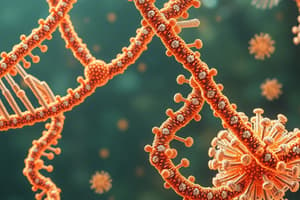Podcast
Questions and Answers
What is a primary difference in the structure of chromosomes between prokaryotes and eukaryotes?
What is a primary difference in the structure of chromosomes between prokaryotes and eukaryotes?
How do prokaryotic and eukaryotic DNA replication speeds differ?
How do prokaryotic and eukaryotic DNA replication speeds differ?
What role does topoisomerase play in prokaryotic DNA replication?
What role does topoisomerase play in prokaryotic DNA replication?
What is a distinct feature of eukaryotic DNA polymerases compared to prokaryotic DNA polymerases?
What is a distinct feature of eukaryotic DNA polymerases compared to prokaryotic DNA polymerases?
Signup and view all the answers
What is the role of telomeres in eukaryotic DNA replication?
What is the role of telomeres in eukaryotic DNA replication?
Signup and view all the answers
What factor contributes to the faster replication in prokaryotes compared to eukaryotes?
What factor contributes to the faster replication in prokaryotes compared to eukaryotes?
Signup and view all the answers
Why are mutations more likely to be damaging in eukaryotes than in prokaryotes?
Why are mutations more likely to be damaging in eukaryotes than in prokaryotes?
Signup and view all the answers
In which way does bacterial replication differ from eukaryotic replication in terms of cellular process?
In which way does bacterial replication differ from eukaryotic replication in terms of cellular process?
Signup and view all the answers
What is a key feature of the lac operon in prokaryotes?
What is a key feature of the lac operon in prokaryotes?
Signup and view all the answers
Which of the following statements accurately describes RNA viruses?
Which of the following statements accurately describes RNA viruses?
Signup and view all the answers
What distinguishes retroviruses from other types of viruses?
What distinguishes retroviruses from other types of viruses?
Signup and view all the answers
Which mutation leads to the complete loss of protein function due to a premature stop codon?
Which mutation leads to the complete loss of protein function due to a premature stop codon?
Signup and view all the answers
What role do sigma factors play in bacterial transcription?
What role do sigma factors play in bacterial transcription?
Signup and view all the answers
In eukaryotes, how is gene organization primarily structured?
In eukaryotes, how is gene organization primarily structured?
Signup and view all the answers
What effect do transcriptional repressors have on gene expression?
What effect do transcriptional repressors have on gene expression?
Signup and view all the answers
What is a characteristic difference between prokaryotic and eukaryotic gene regulation?
What is a characteristic difference between prokaryotic and eukaryotic gene regulation?
Signup and view all the answers
Which open-reading frame mutation results in a changed amino acid sequence?
Which open-reading frame mutation results in a changed amino acid sequence?
Signup and view all the answers
What best describes the main function of transcriptional activators?
What best describes the main function of transcriptional activators?
Signup and view all the answers
How do bacterial systems like quorum sensing affect gene expression?
How do bacterial systems like quorum sensing affect gene expression?
Signup and view all the answers
What role does reverse transcriptase play in retrovirus replication?
What role does reverse transcriptase play in retrovirus replication?
Signup and view all the answers
What is the primary advantage of the DNA replication process in prokaryotes?
What is the primary advantage of the DNA replication process in prokaryotes?
Signup and view all the answers
Study Notes
DNA Replication Differences
- Prokaryotic replication is faster, simpler, has a single initiation site, and involves circular chromosomes, avoiding free DNA end issues. Topoisomerase addresses catenated chromosomes.
- Eukaryotic replication is slower, more complex, with multiple initiation sites for linear chromosomes requiring telomeres. Cell cycle regulation and nucleosome displacement impact the process.
Viral Genome Replication Mechanisms
- RNA viruses: Use RNA-dependent RNA polymerase, have high mutation rates, and +ssRNA genomes act as mRNA directly. -ssRNA genomes produce complementary strands first.
- DNA viruses: Depend on host machinery, dsDNA viruses employ host RNA polymerase, and ssDNA viruses convert to dsDNA for transcription.
- Retroviruses: Use reverse transcriptase to convert RNA into dsDNA, integrate into the host genome, an example being HIV, producing mRNA and viral RNA.
Prokaryotic vs. Eukaryotic Gene Organization
- Prokaryotes: Organize genes into operons (multiple genes share promoter and terminator), creating polycistronic mRNA and regulons (coordinated operons).
- Eukaryotes: Have monocistronic genes, transcribed individually with enhancers, silencers, and undergo mRNA splicing, capping, and polyadenylation.
Effects of Mutations
-
Open Reading Frame (ORF) Mutations:
- Silent: No change in amino acid.
- Missense: Incorrect amino acid.
- Nonsense: Premature stop codon.
- Frameshift: Disrupts the reading frame.
-
Regulatory Mutations:
- Promoter: Affects RNA polymerase binding; no transcription.
- Operator: Affects operons, leading to "on" (constitutive) or "off" (repressed) states.
- Enhancer/Silencer: Alters gene activation/repression.
Bacterial Transcription Regulation
- Promoters: DNA sequences where RNA polymerase binds.
- RNA Polymerase: Synthesizes RNA using a DNA template (requires sigma factor).
- Sigma Factors: Guide RNA polymerase to specific promoters.
- Transcriptional Activators: Increase transcription by enhancing RNA polymerase binding.
- Transcriptional Repressors: Reduce transcription by blocking RNA polymerase.
Genetic Regulation Complexity in Bacteria and Viruses
- Bacteria: Use complex systems (like quorum sensing and sigma factors) to respond to environmental changes and their population density.
- Viruses: Utilize the host for replication, manipulating host machinery, exemplified by HIV's use of Tat (transcription enhancement) and Rev (mRNA export) proteins.
Studying That Suits You
Use AI to generate personalized quizzes and flashcards to suit your learning preferences.
Description
Explore the fundamental differences in DNA replication between prokaryotes and eukaryotes, focusing on their processes and complexities. Delve into the unique replication mechanisms of RNA and DNA viruses, including retroviruses, and understand how these mechanisms impact mutation rates and gene expression.




